2021 Annual Report for: Pterophoridae / Pterophorinae
For species seen in 2021 that had less than or equal to 100 records, full details are included; for more common species, the earliest, latest and highest count by vice-county are shown. The narrative for each species is taken from the main Hantsmoths website, and it is possible that some information on abundance and occurrence can get out of date, as it is impossible to keep up with all changes; however it should give a good introduction to each species. The tables in each species account summarise the previous status, and that for the current year.
For the maps, all records prior to 2021 are shown by a blue dot (the larger the dot, the more recent), with the current year's records shown in red. As previous records are superimposed on any report for 2021, new sites have greater emphasis (i.e. will show as 'more red').
In the species accounts, an asterisk next to a location indicates a new 10km square record; earliest ever dates are highlighted in orange, and latest ever in red. Initials in the species accounts refer to the recorders listed here. Please get in touch if you identify any omissions or errors, in particular if you have records that have yet to be submitted. Details of how to submit records can be found here.
45.004 [B&F: 1501] Triangle Plume Platyptilia gonodactyla ([Denis & Schiffermüller], 1775) - Common
In Hampshire and on the Isle of Wight thinly distributed and local in meadows and woodland margins amongst the foodplant in all three vice-counties. Wingspan 22-28 mm. Larva feeds on stems and leaves of Colt's-foot.
Records prior to 2021
| Vice County | #Records | #Individuals | First Record | Last Record |
|---|---|---|---|---|
| 10 | 29 | 20 | 1856 | 2019 |
| 11 | 36 | 35 | 1973 | 2020 |
| 12 | 15 | 10 | 1971 | 2019 |
2021 records
| Vice County | #Records | #Individuals | Max Quantity |
|---|---|---|---|
| 12 | 1 | 1 | 1 |

Records by year
Records by week (adult)
Records by week (larval)
Record Details
VC12: Kempshott, one, 21 Jul (GAH)
45.008 [B&F: 1504] Yarrow Plume Gillmeria pallidactyla (Haworth, 1811) - Common
Common in a wide range of habitats, both dry and damp, including waste ground and gardens, throughout the British Isles. In Hampshire and on the Isle of Wight widely distributed, but not particularly common. Wingspan 23-27 mm. Similar to P. ochrodactyla but hindleg plain below middle spur, and forewing plainer. Larva feeds on stems and leaves of Yarrow and Sneezewort.
Records prior to 2021
| Vice County | #Records | #Individuals | First Record | Last Record |
|---|---|---|---|---|
| 10 | 35 | 32 | 1856 | 2020 |
| 11 | 231 | 250 | 1971 | 2020 |
| 12 | 91 | 110 | 1976 | 2020 |
2021 records
| Vice County | #Records | #Individuals | Max Quantity |
|---|---|---|---|
| 10 | 4 | 7 | 4 |
| 11 | 6 | 5 | 1 |
| 12 | 3 | 4 | 2 |

Records by year
Records by week (adult)
Records by week (larval)
Record Details
VC10: Bonchurch, one, 27 Jun (JHa); Shanklin, one, 19 Jul; Shanklin Upper Chine, four, 18 Jul; one, 21 Jul (IOut);
VC11: Woodlands, NF, present, 30 Jun (RBW); Allbrook, one, 14 Jul (SIng); Brownwich cliffs, one, 16 Jul (MLO, RJD, KJW); Fareham, one, 30 Jun (MLO); Botley, one, 25 Jul (SLB); Portsmouth, one, 14 Jul (IRT);
VC12: Crawley, one, 12 Jul (GCE); Ropley, two, field observation, 02 Jul (TJN, LFom); Whitehill, one, 02 Jul (ASto)
45.009 [B&F: 1503] Tansy Plume Gillmeria ochrodactyla ([Denis & Schiffermüller], 1775) - Nationally Scarce B
Nationally scarce (Nb) in flower meadows and gardens in parts of England and Wales. In Hampshire the foodplant is very local and so, therefore is the moth, which is known only from the Portsmouth area, where it is common amongst the foodplant. Not recorded from the Isle of Wight to date. Wingspan 24-28 mm. Similar to G. pallidactyla but the third pair of legs in the latter is largely one colour, in the present species it is banded brown and white below the middle spur, and the forewing is more distinctly marked. Gillmeria ochrodactyla flies around tansy (Tanacetum vulgare), and therefore also on ruderal grasslands. G. pallidactyla lives on yarrow (Achillea).
Records prior to 2021
| Vice County | #Records | #Individuals | First Record | Last Record |
|---|---|---|---|---|
| 10 | 1 | 1 | 2017 | 2017 |
| 11 | 23 | 36 | 1978 | 2019 |
2021 records
| Vice County | #Records | #Individuals | Max Quantity |
|---|---|---|---|
| 11 | 1 | 1 | 1 |
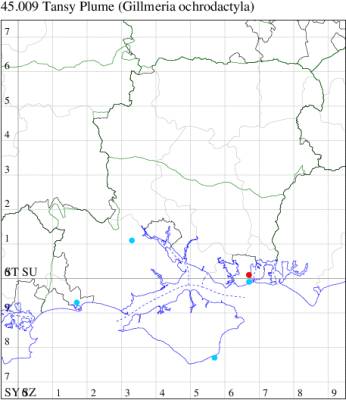
Records by year
Records by week (adult)
Records by week (larval)
Record Details
VC11: Portsmouth, one, 21 Jul (IRT)
45.010 [B&F: 1497] Beautiful Plume Amblyptilia acanthadactyla (Hübner, [1813]) - Common
Common in woodland, heaths and mountains throughout much of the British Isles. In Hampshire and on the Isle of Wight widespread and generally more common than A. punctidactyla. Wingspan 17-23 mm. Very similar to A. punctidactyla, which see for differences. Larva feeds on flowers and leaves of Hedge Woundwort, Common Restharrow, Spiny Restharrow and Meadow Crane's-bill.
Records prior to 2021
| Vice County | #Records | #Individuals | First Record | Last Record |
|---|---|---|---|---|
| 10 | 366 | 644 | 1856 | 2020 |
| 11 | 3526 | 5693 | 1983 | 2020 |
| 12 | 625 | 744 | 1996 | 2020 |
2021 records
| Vice County | #Records | #Individuals | Max Quantity |
|---|---|---|---|
| 10 | 55 | 69 | 3 |
| 11 | 193 | 270 | 10 |
| 12 | 78 | 89 | 3 |

Records by year
Records by week (adult)
Records by week (larval)
Record Summary
VC10: Earliest: Bonchurch, 20 Feb, 1 (JHa) Latest: Shanklin, 16 Nov, 1 (IOut) Max count: Freshwater, 14 Aug, 3 (DCoo)
VC11: Earliest: Horndean, 20 Feb, 1 (PHog) Latest: Portchester, 16 Dec, 1 (DH-J) Max count: Portsmouth, 10 Aug, 10 (IRT)
VC12: Earliest: Church Crookham, 15 Feb, 1 (DDim) Latest: Blackwater, 18 Nov, 1 (BDal) Max count: Basingstoke, 08 Oct, 3 (MJW)
45.011 [B&F: 1498] Brindled Plume Amblyptilia punctidactyla (Haworth, 1811) - Local
Local in woodland, heaths and river-banks throughout much of the British Isles. In Hampshire and on the Isle of Wight widespread, but generally less common than A. acanthadactyla. Wingspan 18-23 mm. Confusable with A. acanthadactyla. A. punctidactyla has a greyish or, when fresh, dark greenish tinge, whereas A. acanthadactyla is reddish; also, A. punctidactyla has a lot of speckling on the basal half of the forewings, A. acanthadactyla has very little. Larva feeds on flowers and seeds of Hedge Woundwort, Common Restharrow, Spiny Restharrow and Meadow Crane's-bill.
Records prior to 2021
| Vice County | #Records | #Individuals | First Record | Last Record |
|---|---|---|---|---|
| 10 | 12 | 11 | 1900 | 2019 |
| 11 | 103 | 107 | 1984 | 2019 |
| 12 | 47 | 48 | 1982 | 2020 |
2021 records
| Vice County | #Records | #Individuals | Max Quantity |
|---|---|---|---|
| 11 | 2 | 2 | 1 |
| 12 | 3 | 3 | 1 |

Records by year
Records by week (adult)
Records by week (larval)
Record Details
VC11: Totton, one, 24 Aug (TRac); Romsey, one, 01 Jul (NRJ det. CHar);
VC12: Great Haughurst Copse, Axmansford, one, 08 Jul (ACB, GJD); Pamber Forest, one, 16 Jun (GJD)
45.012 [B&F: 1509] Brown Plume Stenoptilia pterodactyla (Linnaeus, 1761) - Common
Common in downland, open woodland and dry pastures throughout much of the British Isles, more numerous in the south. In Hampshire and on the Isle of Wight recorded from all three vice-counties, but with few records from the Isle of Wight. Wingspan 20-26 mm. Larva feeds on flowers, leaves and seeds of Germander Speedwell.
Records prior to 2021
| Vice County | #Records | #Individuals | First Record | Last Record |
|---|---|---|---|---|
| 10 | 26 | 26 | 1856 | 2020 |
| 11 | 119 | 192 | 1971 | 2020 |
| 12 | 168 | 201 | 1971 | 2020 |
2021 records
| Vice County | #Records | #Individuals | Max Quantity |
|---|---|---|---|
| 10 | 2 | 2 | 1 |
| 11 | 12 | 15 | 2 |
| 12 | 25 | 150 | 32 |
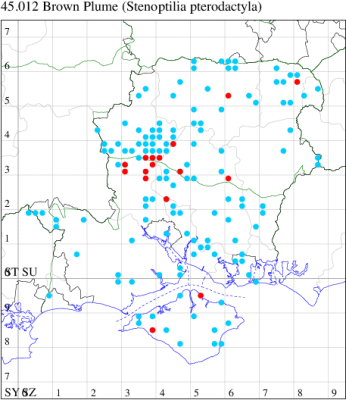
Records by year
Records by week (adult)
Records by week (larval)
Record Details
VC10: Brook Down, one, gen det, 07 Jul (PBar); Osborne Valley Walk, one, gen det, 22 Jul (IOut);
VC11: Ashley, one, 24 Jul; Broughton, one, 08 Jul; one, 08 Jul; one, 25 Jul; one, 08 Jul; two, 08 Jul; two, 25 Jul; Ashley, two, 24 Jul; Winter Down Copse, Little Somborne, one, 19 Jul; one, 19 Jul; Crawley, one, 28 Jun (GCE); Chandlers Ford, one, indoors, 01 Jul (AJB);
VC12: Stockbridge Down NT, one, field observation, 02 Jul (MDuf det. PEH); Little Somborne, two, 12 Jul; two, 12 Jul; two, 13 Aug; Crawley, one, 17 Jul; one, 12 Jul; Barton Stacey, two, 01 Aug (GCE); Harestock, one, 20 Jul; one, 07 Aug (GRog); Cheriton Wood, five, field observation, 30 Jun; three, field observation, 05 Jul (DAS); Basingstoke, one, 19 Jul (MJW); Minley Wood, four, field observation, 21 Jun; three, field observation, 23 Jun; three, field observation, 24 Jun; 17, field observation, 30 Jun; 14, field observation, 03 Jul; three, field observation, 04 Jul; 12, field observation, 06 Jul; 18, field observation, 09 Jul; 32, field observation, 10 Jul; 13, field observation, 13 Jul; seven, field observation, 17 Jul; one, field observation, 07 Aug; one, field observation, 10 Aug (BDal)
45.013 [B&F: 1508] Twin-spot Plume Stenoptilia bipunctidactyla (Scopoli, 1763) - Common
Common on damp heathland, downland and in flower meadows throughout much of the British Isles, where suitable habitat exists. In Hampshire and on the Isle of Wight the species is found sparsely in all three vice-counties. Wingspan 17-25 mm. Larva feeds on flowers and seeds of Devil's-bit Scabious, Field Scabious and Small Scabious.
Records prior to 2021
| Vice County | #Records | #Individuals | First Record | Last Record |
|---|---|---|---|---|
| 10 | 16 | 6 | 1856 | 2018 |
| 11 | 22 | 36 | 1975 | 2016 |
| 12 | 37 | 48 | 1986 | 2020 |
2021 records
| Vice County | #Records | #Individuals | Max Quantity |
|---|---|---|---|
| 12 | 2 | 2 | 1 |
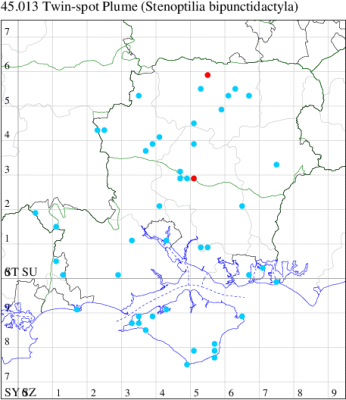
Records by year
Records by week (adult)
Records by week (larval)
Record Details
VC12: Magdalen Hill Down NR, one, field observation, 24 Aug (DAS); Wolverton, one, field observation, 15 Jul (ACB)
45.021 [B&F: 1507] Dowdy Plume Stenoptilia zophodactylus (Duponchel, 1840) - Local
Local on sea cliffs, dry grassland and sand-dunes throughout much of England. In Hampshire and on the Isle of Wight has been recorded in the past from all three vice-counties, but there are no recent records from north Hampshire, and the species is probably under-recorded in the south and on the Island. Wingspan 16-23 mm. Larva feeds on flowers and seeds of Centaury, Yellow-wort and Gentian.
Records prior to 2021
| Vice County | #Records | #Individuals | First Record | Last Record |
|---|---|---|---|---|
| 10 | 12 | 6 | 1856 | 2018 |
| 11 | 20 | 33 | 1973 | 2017 |
| 12 | 3 | 3 | 2011 | 2020 |
2021 records
| Vice County | #Records | #Individuals | Max Quantity |
|---|---|---|---|
| 11 | 1 | 1 | 1 |
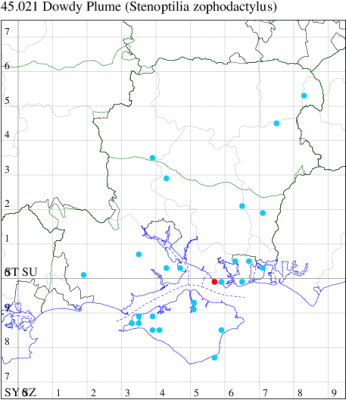
Records by year
Records by week (adult)
Records by week (larval)
Record Details
VC11: Browndown Coastal Ranges, one, seen by RJDickson, 27 Aug (MLO, ADT, DWal, KJW)
45.022 [B&F: 1496] Rose Plume Cnaemidophorus rhododactyla ([Denis & Schiffermüller], 1775) - Nationally Scarce A
Nationally scarce (Na) in hedgerows and woodland in parts of south-eastern England. In Hampshire known only from Botley Wood, where it was first seen in 1977, with a probable immigrant individual being the first on the Isle of Wight in 2020. Wingspan 18-26 mm. A fairly distinctive plume moth. Larva feeds on buds, flowers and leaves of Wild Rose, Dog-rose and Cultivated Rose.
Records prior to 2021
| Vice County | #Records | #Individuals | First Record | Last Record |
|---|---|---|---|---|
| 10 | 2 | 2 | 2009 | 2020 |
| 11 | 4 | 5 | 1977 | 2008 |
2021 records
| Vice County | #Records | #Individuals | Max Quantity |
|---|---|---|---|
| 11 | 1 | 1 | 1 |
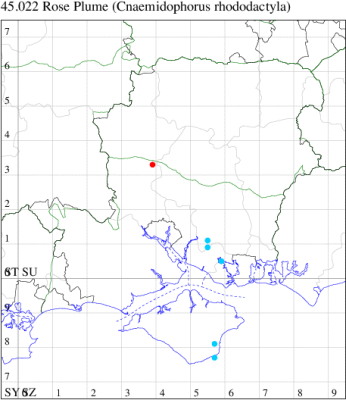
Records by year
Records by week (adult)
Records by week (larval)
Record Details
VC11: Winter Down Copse, Little Somborne, one, 19 Jul (GCE)
45.023 [B&F: 1495] Crescent Plume Marasmarcha lunaedactyla (Haworth, 1811) - Local
Local on downland, shingle beaches and sand-dunes throughout much of southern England and southern Wales, where suitable habitat exists. In Hampshire and on the Isle of Wight probably occurs wherever the foodplant occurs. Wingspan 18-22 mm. Recognised by the cream-coloured moon-shaped marking on outer part of forewing. Larva feeds on stems and leaves of Common Restharrow.
Records prior to 2021
| Vice County | #Records | #Individuals | First Record | Last Record |
|---|---|---|---|---|
| 10 | 87 | 227 | 1856 | 2020 |
| 11 | 250 | 455 | 1973 | 2020 |
| 12 | 51 | 80 | 1996 | 2020 |
2021 records
| Vice County | #Records | #Individuals | Max Quantity |
|---|---|---|---|
| 10 | 7 | 13 | 5 |
| 11 | 5 | 6 | 2 |
| 12 | 3 | 3 | 1 |

Records by year
Records by week (adult)
Records by week (larval)
Record Details
VC10: Totland Bay, one, field observation, 24 Jul (DCoo); Yarmouth, two, field observation, 30 Jun; Chale, five, field observation, 12 Jul (PBar); Newport, one, 19 Jul (DPl); Newtown NNR, one, 02 Jul; Rew Down, Ventnor, two, 15 Jul (PBar); Wheelers Bay, one, 19 Jul (ABut);
VC11: Kings Somborne, two, 29 Jun; Broughton, one, 25 Jul; one, 08 Jul (GCE); Fareham, one, 01 Jul (IMcP); New Milton, one, 18 Jul (RPH);
VC12: Morn Hill, Winchester, one, 17 Jul (CBey, DAS, PDF); Basingstoke, one, 14 Jul; one, 18 Jul (RHil)
45.025 [B&F: 1490] Small Plume Oxyptilus parvidactyla (Haworth, 1811) - Nationally Scarce B
Local, on heaths, dry pastures and chalk downland, throughout the British Isles. In Hampshire, locally common on unspoilt downland, but not recorded recently from the Isle of Wight. Wingspan 13-18mm. Difficult to differentiate from other Oxyptilus, unless reared from the host plant or via dissection. A diurnal moth, and can be seen in afternoon sunshine, until dusk. The flight period is June to July. Larva feeds on Mouse-ear Hawkweed, living within a spun or rolled leaf.
Records prior to 2021
| Vice County | #Records | #Individuals | First Record | Last Record |
|---|---|---|---|---|
| 10 | 3 | 0 | 1856 | 1880 |
| 11 | 12 | 11 | 1972 | 2019 |
| 12 | 7 | 5 | 1971 | 2020 |
2021 records
| Vice County | #Records | #Individuals | Max Quantity |
|---|---|---|---|
| 11 | 1 | 1 | 1 |
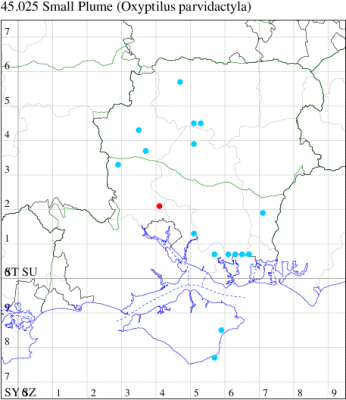
Records by year
Records by week (adult)
Records by week (larval)
Record Details
VC11: Chandlers Ford, one, 19 Jul (BEll)
45.030 [B&F: 1513] White Plume Pterophorus pentadactyla (Linnaeus, 1758) - Common
Common in dry grassland, waste ground and gardens throughout the British Isles. Widespread and common in Hampshire and on the Isle of Wight, wherever bindweed is well-established. Wingspan 24-35 mm. Flies at dusk and through the night, often appearing at lighted windows at dusk. The only completely all-white plume moth. Larva feeds on Bindweed.
Records prior to 2021
| Vice County | #Records | #Individuals | First Record | Last Record |
|---|---|---|---|---|
| 10 | 256 | 363 | 1978 | 2020 |
| 11 | 794 | 846 | 1967 | 2020 |
| 12 | 532 | 624 | 1974 | 2020 |
2021 records
| Vice County | #Records | #Individuals | Max Quantity |
|---|---|---|---|
| 10 | 17 | 17 | 2 |
| 11 | 25 | 25 | 2 |
| 12 | 17 | 15 | 1 |
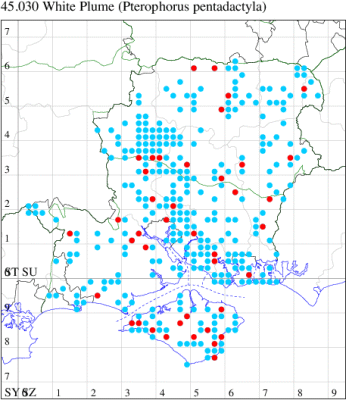
Records by year
Records by week (adult)
Records by week (larval)
Record Details
VC10: Totland, one, field observation, 24 Jul; two, field observation, 30 Aug (RTer); Freshwater, one, 06 Jun (DCoo); one, 01 Jul; one, 29 Jun; Brook Down, one, 07 Jul (PBar); Brighstone Bay, , one, 03 Jul (MDun); Plaish, Carisbrooke, one, 24 Jul (KRyl); Newport, one, 02 Jul; one, 13 Jul (DPl); Bonchurch, one, 28 Jun; one, 14 Jul (JHa); Rookley, one, 02 Jul (JRB); Haseley Manor, one, 13 Jul; Shanklin, one, 18 Jul (IOut); , present, 20 Jul (iNat); Ryde, one, field observation, 30 Jul (JMas);
VC11: Fordingbridge, one, 02 Jul (SCT); Marchwood, one, 16 Jul (TDCh); Woodlands, NF, present, 09 Jul (RBW); Totton, one, field observation, 26 Jul (TRac); one, 09 Jun (LHan); Romsey, one, 18 Jul (NRJ); Stockbridge Down NT, one, 18 Jul; one, 18 Jul; Ashley, one, 26 Jun (GCE); Swaythling, Southampton, one, 09 Jul (MEdg); Allbrook, one, 15 Jul (SIng); Fareham, one, in flight, 22 Jul (IMcP); one, 20 Jul; one, 21 Jul (MLO); Botley, one, 19 Jul; one, 05 Sep (SLB); Portsmouth, one, 18 Jul; two, 19 Jul; one, 20 Jul (IRT); West Meon, one, 02 Jul (RJD, MLO, ADT, DWal, KJW); Horndean, one, 25 Jun (PHog); Petersfield, one, 19 Jul (RAll); Hengistbury Head, one, 13 Jul (SDar); New Milton, one, 18 Jul; one, 22 Jul (RPH);
VC12: Little Somborne, one, 12 Jul; Crawley, one, 17 Jul; one, 12 Jul; one, 17 Jul (GCE); Winchester, present, field observation, 04 Aug (iNat); Hinton Ampner, one, 09 Jul; one, 16 Jul (ASD); Kempshott, one, 15 Jul (GAH); Ecchinswell, one, to a lighted window, 28 Jun; one, field observation, 05 Jul; one, field observation, 07 Jul (MJN); Axmansford, one, to lighted window, 24 Jul (ACB); Alresford, present, field observation, 08 Jul (iNat); Basingstoke, one, 01 Jul; one, 11 Aug (MJW); Whitehill, one, 02 Jul (ASto); Farnborough, one, 14 Jun (MThop)
45.031 [B&F: 1514] Spotted-white Plume Porrittia galactodactyla ([Denis & Schiffermüller], 1775) - Nationally Scarce B
Nationally scarce (Nb) in open woodland and dry pastures throughout much of southern England and southern Wales. In Hampshire and on the Isle of Wight recorded from all three vice-counties but not recently from the Isle of Wight. Wingspan 20-25 mm. Forewing pale with diagnostic backward-pointing rear lobe, but imago seldom encountered, and the species is much more likely to be recorded in the larval stage, when feeding signs are relatively easy to find where they are present. Larva feeds on Lesser and Greater Burdock, making characteristic large holes in the leaves and often found nearby, resting along the edge of a vein on the underside of the leaf.
Records prior to 2021
| Vice County | #Records | #Individuals | First Record | Last Record |
|---|---|---|---|---|
| 10 | 4 | 0 | 1900 | 1929 |
| 11 | 39 | 98 | 1974 | 2020 |
| 12 | 30 | 43 | 1975 | 2020 |
2021 records
| Vice County | #Records | #Individuals | Max Quantity |
|---|---|---|---|
| 12 | 1 | 0 | 0 |

Records by year
Records by week (adult)
Records by week (larval)
Record Details
VC12: Old Burghclere, larval feeding signs, present, field observation, feeding damage on around 10 burdock plants, 06 Jun (GJD)
45.033 [B&F: 1510] Thyme Plume Merrifieldia leucodactyla ([Denis & Schiffermüller], 1775) - Local
Local on chalk downland, sea cliffs and sandhills throughout the British Isles. In Hampshire recorded on the downs in small numbers, barely annually. Not recorded reliably on the Isle of Wight to date. Wingspan 18-25 mm. Thoroughly confused in the past with M. tridactyla from which separated only by microscopic examination of the antennae. Larva feeds on Wild Thyme.
Records prior to 2021
| Vice County | #Records | #Individuals | First Record | Last Record |
|---|---|---|---|---|
| 11 | 8 | 7 | 1975 | 2011 |
| 12 | 14 | 5 | 1981 | 2015 |
2021 records
| Vice County | #Records | #Individuals | Max Quantity |
|---|---|---|---|
| 12 | 1 | 1 | 1 |

Records by year
Records by week (adult)
Records by week (larval)
Record Details
VC12: Anna Valley, Andover, one, 20 Jul (TJN, LFom)
45.034 [B&F: 1512] Dingy White Plume Merrifieldia baliodactylus (Zeller, 1841) - Nationally Scarce B
Nationally scarce (Nb) on chalk downland and waste ground, mainly in the southern counties of England. In Hampshire restricted to the few areas of unimproved grassland at sites such as Oxenbourne, Stockbridge and Magdalen Hill Down. Recently recorded on the Isle of Wight for the first time since 1981. Wingspan 20-27 mm. Very similar to several other species of plume moth, from which separable only by dissection of the genitalia. Larva feeds on stems of Wild Marjoram.
Records prior to 2021
| Vice County | #Records | #Individuals | First Record | Last Record |
|---|---|---|---|---|
| 10 | 13 | 10 | 1856 | 2019 |
| 11 | 20 | 26 | 1971 | 2020 |
| 12 | 23 | 24 | 1971 | 2020 |
2021 records
| Vice County | #Records | #Individuals | Max Quantity |
|---|---|---|---|
| 11 | 1 | 1 | 1 |
| 12 | 1 | 1 | 1 |
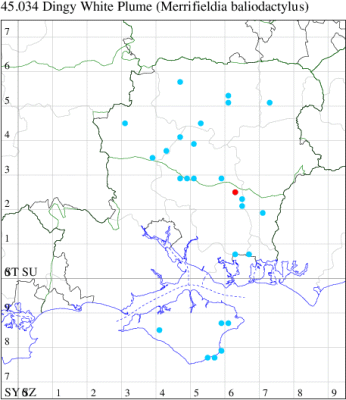
Records by year
Records by week (adult)
Records by week (larval)
Record Details
VC11: West Meon, one, gen det, 02 Jul (RJD, MLO, ADT, DWal, KJW det. RJD);
VC12: Basingstoke, one, 23 Jul (DJJ)
45.037 [B&F: 1523] Dusky Plume Oidaematophorus lithodactyla (Treitschke, 1833) - Local
Local on grassland, roadside verges and embankments throughout much of England and western Ireland. In Hampshire and on the Isle of Wight local amongst the foodplants, and found in all three vice-counties, but doubtless under-recorded. Wingspan 26-29 mm. Noticeable scale tufts on tibia. Larva feeds on flowers, stems and leaves of Common Fleabane.
Records prior to 2021
| Vice County | #Records | #Individuals | First Record | Last Record |
|---|---|---|---|---|
| 10 | 26 | 14 | 1880 | 2019 |
| 11 | 172 | 350 | 1972 | 2020 |
| 12 | 26 | 31 | 1987 | 2020 |
2021 records
| Vice County | #Records | #Individuals | Max Quantity |
|---|---|---|---|
| 10 | 1 | 1 | 1 |
| 11 | 1 | 2 | 2 |
| 12 | 1 | 1 | 1 |
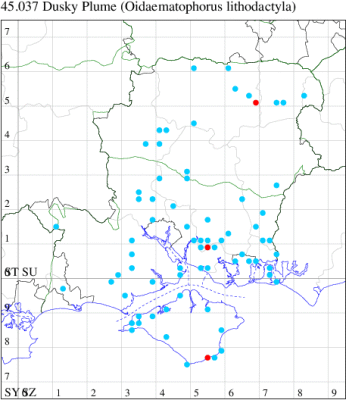
Records by year
Records by week (adult)
Records by week (larval)
Record Details
VC10: Rew Down, Ventnor, one, 13 Jul (PBar);
VC11: Botley Wood, two, 30 Jul (RJD, DWal, KJW);
VC12: Mapledurwell, one, 11 Aug (MBot)
45.039 [B&F: 1519] Citron Plume Hellinsia carphodactyla (Hübner, [1813]) - Local
Local on chalky ground in parts of southern England. This is true of Hampshire and on the Isle of Wight where recorded from all three vice-counties at low density. Wingspan 14-23 mm. Larva feeds within flowerheads of Ploughman's-spikenard.
Records prior to 2021
| Vice County | #Records | #Individuals | First Record | Last Record |
|---|---|---|---|---|
| 10 | 45 | 65 | 1900 | 2019 |
| 11 | 37 | 29 | 1990 | 2019 |
| 12 | 9 | 7 | 1979 | 2020 |
2021 records
| Vice County | #Records | #Individuals | Max Quantity |
|---|---|---|---|
| 10 | 2 | 2 | 1 |

Records by year
Records by week (adult)
Records by week (larval)
Record Details
VC10: Brook Down, one, gen det, 07 Jul (PBar); Osborne Valley Walk, one, 22 Jul (IOut)
45.043 [B&F: 1517] Hemp Agrimony Plume Adaina microdactyla (Hübner, [1813]) - Common
Common on downland throughout England, more numerous in the south. In Hampshire and on the Isle of Wight locally common amongst Hemp-agrimony, especially where the plant is growing in drier localities. Wingspan 13-17 mm. Small size precludes confusion with most other species of plume moth. Larva feeds within stems of Hemp-agrimony, forming galls.
Records prior to 2021
| Vice County | #Records | #Individuals | First Record | Last Record |
|---|---|---|---|---|
| 10 | 148 | 246 | 1880 | 2020 |
| 11 | 211 | 269 | 1973 | 2019 |
| 12 | 180 | 381 | 1980 | 2020 |
2021 records
| Vice County | #Records | #Individuals | Max Quantity |
|---|---|---|---|
| 10 | 9 | 13 | 5 |
| 11 | 5 | 6 | 2 |
| 12 | 3 | 3 | 1 |
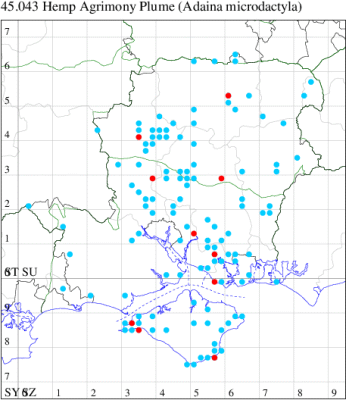
Records by year
Records by week (adult)
Records by week (larval)
Record Details
VC10: Totland, one, 22 Jul; one, 23 Jul; one, 24 Jul; one, 25 Jul; one, 26 Jul; one, 27 Jul; one, 30 Jul (RTer); Freshwater Cliffs, five, field observation, 28 May (SDav); Bonchurch, one, 07 Jun (JHa);
VC11: Kings Somborne, two, 09 Jun (GCE); Fareham, one, 21 Jul (MLO); Botley, one, 14 Sep (SLB); Wickham, one, 22 Jul (JRDS); Browndown Coastal Ranges, one, 20 Aug (RJD, MLO, DWal, KJW);
VC12: Goodworth Clatford, one, 30 Aug (GCE); Cheriton, one, field observation, 30 May (DAS); Basingstoke, one, 19 Jul (MJW)
45.044 [B&F: 1524] Common Plume Emmelina monodactyla (Linnaeus, 1758) - Common
Common in gardens, rough ground, hedgerows and woodland edges throughout much of the British Isles. In Hampshire and on the Isle of Wight common to abundant throughout. Wingspan 18-27 mm. The imago hibernates and comes to light early in the year. Larva polyphagous on plants such as Bindweed, Knotgrass, Bilberry and Heather, living between shoots spun together with silk.
Records prior to 2021
| Vice County | #Records | #Individuals | First Record | Last Record |
|---|---|---|---|---|
| 10 | 1138 | 2610 | 1856 | 2020 |
| 11 | 9739 | 18501 | 113 | 2020 |
| 12 | 2541 | 4112 | 1976 | 2020 |
2021 records
| Vice County | #Records | #Individuals | Max Quantity |
|---|---|---|---|
| 10 | 127 | 304 | 23 |
| 11 | 488 | 793 | 8 |
| 12 | 194 | 260 | 7 |

Records by year
Records by week (adult)
Records by week (larval)
Record Summary
VC10: Earliest: Cranmore, 11 Jan, 1 (CHic) Latest: Totland, 25 Dec, 1 (RTer) Max count: Freshwater, 06 Oct, 23 (DCoo)
VC11: Earliest: Botley, 19 Feb, 1 (SLB) Latest: Totton, 31 Dec, 1 (CNB) Max count: Totton, 17 Aug, 8 (LHan)
VC12: Earliest: Blackwater, 17 Jan, 1 (BDal) Latest: Alton, 31 Dec, 1 (DBO) Max count: Blackwater, 20 Aug, 7 (BDal)
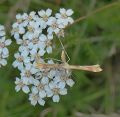

()(IMG_5612).jpg)
(detail of wing)(IMG_5617).jpg)